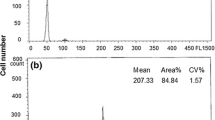Abstract
Using denaturing SDS-polyacrylamide gel electrophoresis, a protein with a subunit MW of about 148,000 daltons could be detected in the fat body of females of the reciprocal hybrids ofChironomus thummi thummi andChironomus thummi piger, which is not present in males. This protein is presumably a vitellogenin and can be found in both hybrids during the late fourth-instar larval stage until eclosion of the adults, i.e., in early vitellogenesis. After eclosion, the reciprocal hybrids behave differently concerning the 148-kd protein. In females of thepiger ♀ × thummi ♂ cross, which are fertile and produce yolky eggs, the 148-kd protein disappears from the fat body immediately after eclosion. In females of the reciprocal cross (thummi ♀ × piger ♂) which are affected by gonadal dysgenesis and in which the oocytes only rarely contain yolk, the 148-kd protein is still present in the fat body of the adult up to 50 hr after eclosion until the fat body degrades. It is concluded that the inability of the sterilethummi ♀ × piger ♂ females to produce yolky eggs is caused by an impaired uptake of the presumed 148-kd vitellogenin into oocytes and not by a defective vitellogenesis. The impaired vitellogenin deposition into oocytes is taken as another aberrant trait of gonadal dysgenesis of thethummi ♀ × piger ♂ hybrids.
Similar content being viewed by others
References
Bregliano, J.-C., and Kidwell, M. G. (1983). Hybrid dysgenesis determinants. In Shapiro, J.-A. (ed.),Mobile Genetic Elements Academic Press, New York, pp. 363–410.
Engels, W.-R. (1983). The P family of transposable elements in Drosophila.Annu. Rev. Genet. 17315.
Ginsburg, L. R., Bingham, P. W., and Yoo, S. (1984). On the theory of speciation induced by transposable elements.Genetics 107331.
Hagedorn, H. H., and Kunkel, J. G. (1979). Vitellogenin and vitellin in insects.Annu. Rev. Biochem. 24475.
Hägele, K. (1975). Chironomus. In King, R. C. (ed.),Handbook of Genetics Plenum Press, New York, Vol. 3, pp. 269–273.
Hägele, K. (1984). Different hybrid effects in reciprocal crosses between Chironomus thummi thummi and Ch. th. piger including spontaneous chromosome aberrations and sterility.Genetica 63105.
Hägele, K. (1987). Non-reciprocal gonadal dysgenesis in Chironomus thummi hybrids. I. Temperature sensitivity of female sterility.Dev. Genet. 817.
Hägele, K., and Oschmann, B. (1987). Non-reciprocal gonadal dysgenesis in hybrids of the chironomid midge Chironomus thummi. III. Germ line specific abnormalities.Chromosoma 9650.
Hägele, K., and Oschmann, B. (1989). Non-reciprocal gonadal dysgenesis in hybrids of the chironomid midge Chironomus thummi II. Gonadal-dysgenesis inducing chromosomes.Genetica 78185.
Karess, R. E., and Rubin, G. M. (1984). Analysis of P elements functions in Drosophila.Cell 38135.
Kidwell, M. G., Kimura, K., and Black, D. M. (1988). Evolution of hybrid dysgenesis potential following P element contamination in Drosophila melanogaster.Genetics 119815.
Laemmli, U. K. (1970). Cleavage of structural proteins during the assembly of the head of bacteriophage T4.Nature 27680.
Laufer, H., Vafopoulou-Mandalos, X., and Deak, P. (1986) Ecdysteroid titres in Chironomus and their relation to haemoglobins and vitellogenins.Insect Biochem. 16281.
Nicklas, R. B., and Staehly, C. A. (1967). Chromosome micromanipulation. I. The mechanics of chromosome attachment to the spindle.Chromosoma 211.
Oschmann, B. (1986).Determinanten der Gonadendysgenesie bei Chironomus thummi thummi × Ch. th. piger Bastarden, Masters thesis, Ruhr-Universität Bochum.
Segrest, J. P., and Jackson, R. L. (1972). Molecular weight determination of glycoproteins by polyacrylamide gel electrophoresis in sodium dodecylsulfate. In Ginsburg, V. (ed.),Methods in Enzymology, Vol 28 Academic Press, New York, Part B, pp. 54–63.
Simmons, M. S., and Karess, R. E. (1985) Molecular and population biology of hybrid dysgenesis.Dros. Inf. Serv. 612.
Travis, J. L., and Schin, K. (1977). Developmental studies of vitellogenesis in a dipteran insect, Chironomus thummi.Differentiation 7113.
Whittaker, J. R., and West, H. S. (1962). A starch gel electrophoretic study of insect hemolymph protein.Can. J. Zool. 40655.
Wülker, W., and G. Winter. (1970). Untersuchungen über die Ultrastruktur der Gonaden von Chironomus (Dipt.). I. Normalentwicklung der Ovarien im 4. Larvenstadium.Z. Zellforsch. 106348.
Wyatt, G. R., and Pan, M. L. (1978). Insect plasma proteins.Annu. Rev. Biochem. 47779.
Wyatt, G. R., Locke, J., and Bradfield, J. Y. (1984). The vitellogenin genes of Locusta migratoria and other insects. In Engel, W., et al. (eds.),Advances in Invertebrate Reproduction 3 Elsevier, Amsterdam, pp. 73–106.
Author information
Authors and Affiliations
Rights and permissions
About this article
Cite this article
Hägele, K. Nonreciprocal gonadal dysgenesis in hybrids of the chironomid midgeChironomus thummi. IV. Behavior of a female-specific protein, probably a vitellogenin. Biochem Genet 28, 477–485 (1990). https://doi.org/10.1007/BF00554375
Received:
Revised:
Issue Date:
DOI: https://doi.org/10.1007/BF00554375




